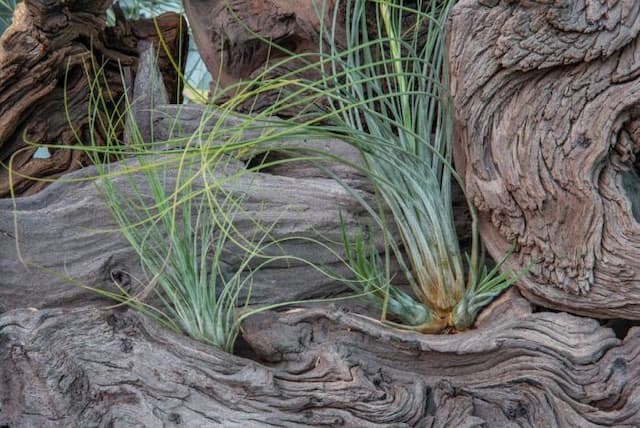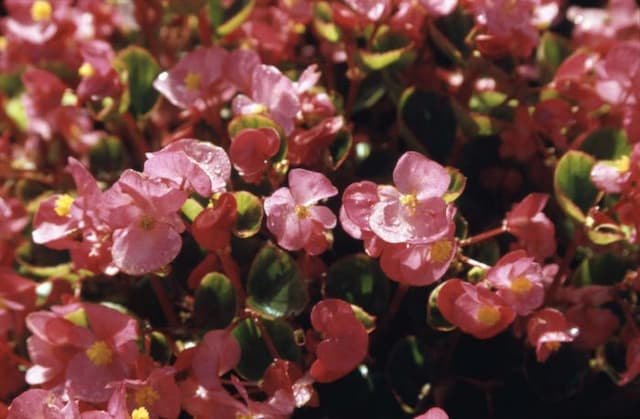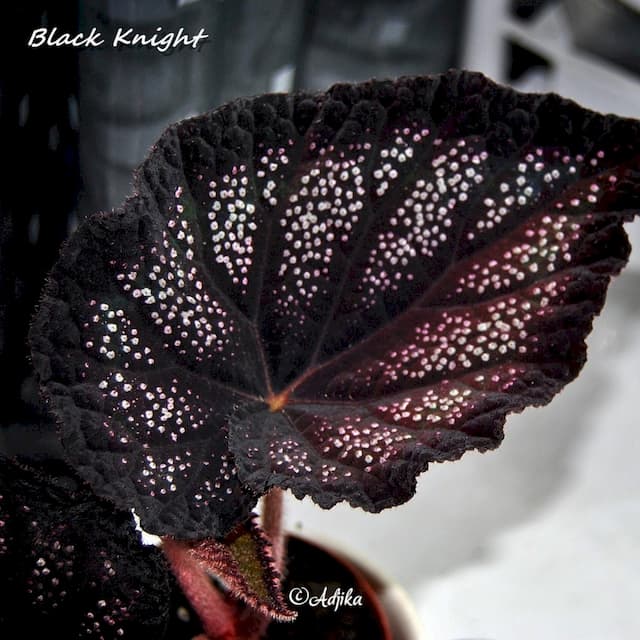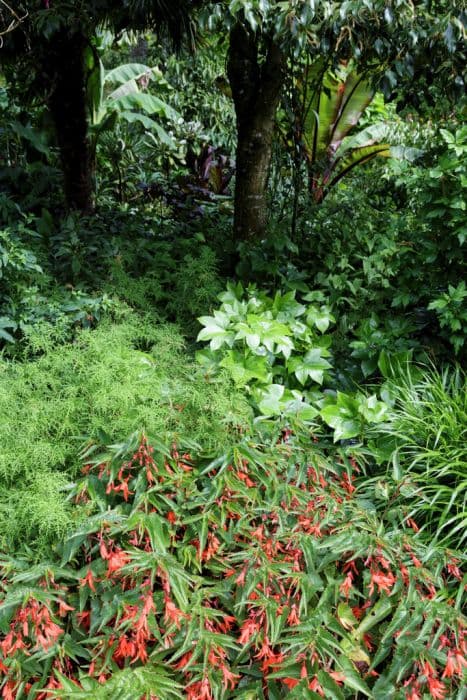Encanto Orange Begonia Begonia 'Encanto Orange' (PBR)

ABOUT
The Begonia 'Encanto Orange' is a vibrant and showy plant known for its abundant, bright orange flowers that emerge throughout the blooming season, adding a burst of color to garden spaces and containers. The flowers have a lush, full appearance, with each blossom composed of multiple layers of delicate petals, creating a striking visual impact. The foliage of 'Encanto Orange' forms a lush backdrop to the radiant blooms. The leaves are typically a rich green, with a glossy surface that gleams in the sunlight. Their edges are subtly waved or serrated, adding a touch of texture to the plant's overall appearance. The leaves may also exhibit occasional hints of red or dark markings, further enhancing the ornate presentation of this begonia variety. Together, the fiery orange flowers and the verdant foliage create a contrasting palette that is both eye-catching and pleasing to the eye, making Begonia 'Encanto Orange' a popular choice for adding a splash of color to outdoor areas. Additionally, this begonia could be a focal point in container gardens, where its ornamental qualities can be admired up close.
About this plant
 Names
NamesFamily
Begoniaceae
Synonyms
Encanto Orange Begonia, Orange Begonia
Common names
Begonia 'Encanto Orange' (PBR)
 Toxicity
ToxicityTo humans
Begonia 'Encanto Orange' is not highly toxic to humans, but it can cause irritation. If ingested, the most common symptoms may include irritation of the mouth, lips, throat, and stomach, potentially leading to nausea and vomiting. Handling the plant may also result in skin irritation or a rash for those with sensitive skin or allergies.
To pets
For pets, begonia, including Begonia 'Encanto Orange', contains soluble calcium oxalates which can be toxic when ingested. If a pet chews or ingests any part of a begonia plant, they could experience symptoms such as oral irritation, drooling, vomiting, and difficulty swallowing. In severe cases, ingestion can lead to kidney failure, especially in pets like cats and dogs which are more prone to chewing on plants.
 Characteristics
CharacteristicsLife cycle
Perennials
Foliage type
Evergreen
Color of leaves
Green
Flower color
Orange
Height
1-1.5 feet (30-45 cm)
Spread
1-1.5 feet (30-45 cm)
Plant type
Herb
Hardiness zones
9
Native area
South America
Benefits
 General Benefits
General Benefits- Enhanced Aesthetics: The Begonia 'Encanto Orange' offers vibrant orange flowers that can brighten up any garden space.
- Low Maintenance: It is relatively easy to care for, requiring minimal upkeep compared to more demanding plants.
- Drought Tolerant: Once established, it can tolerate periods of drought, making it suitable for various climatic conditions.
- Continuous Blooming: This plant often flowers from spring to fall, providing a long season of visual interest.
- Attracts Pollinators: The bright flowers attract bees and butterflies, which are beneficial for pollinating other plants in the garden.
- Versatile Planting: Suitable for containers, borders, and hanging baskets, allowing for use in a range of garden designs and spaces.
- Avoids Deer: Typically resistant to deer, which can be a significant advantage in areas where deer predation is a problem.
- Compact Growth: Its compact size makes it ideal for small gardens or spaces, without the risk of it overtaking other plantings.
 Medical Properties
Medical PropertiesThis plant is not used for medical purposes.
 Air-purifying Qualities
Air-purifying QualitiesThis plant is not specifically known for air purifying qualities.
 Other Uses
Other Uses- Photography Subject - The vibrant orange blooms of Begonia can serve as an excellent subject for photographers looking to capture the vivacity of a garden setting.
- Art Inspiration - Artists may draw inspiration from the intricate patterns and colors of Begonia petals for their paintings or textile designs.
- Education - Begonias can be used to teach botany students about hybridization and plant genetics, illustrating how new varieties like 'Encanto Orange' are created.
- Theme Gardens - Begonias can play a central role in theme gardens, especially in an orange color-themed landscape design for a visually striking effect.
- Event Decorations - The cheerful orange flowers of Begonia can be used to create table centerpieces or decorations at events and celebrations.
- Culinary Garnish - Though not widely recognized as an edible, petals of some begonia varieties may be used as a colorful, non-toxic garnish for culinary dishes.
- Community Projects - Begonias can be planted as part of community gardening projects, serving as a tool for social engagement and neighborhood beautification.
- Crafting - Dried Begonia flowers or leaves can be used in scrapbooking, greeting card making, or other craft projects for a touch of natural beauty.
- Personal Care - Some begonia petals can be infused in water to create a fragrant rinse or bath soak with a non-medical, calming aesthetic experience.
- Color Matching - A Begonia's vibrant hue can be used by designers and home decorators as a reference point for color matching in interior design projects.
Interesting Facts
 Feng Shui
Feng ShuiThe Begonia is not used in Feng Shui practice.
 Zodiac Sign Compitability
Zodiac Sign CompitabilityThe Begonia is not used in astrology practice.
 Plant Symbolism
Plant Symbolism- Caution: Begonias are often associated with warnings or caution, possibly due to their delicate appearance which might suggest vulnerability.
- Harmony: The vibrant orange color of 'Encanto Orange' Begonia can symbolize joy, warmth, and harmony, reflecting an environment of positive and friendly energy.
- Individuality: Due to their unique and diverse range, begonias can represent individuality and the importance of standing out in a crowd.
- Fanciful nature: The Begonia 'Encanto Orange', with its bright appearance, can convey a sense of whimsy and playfulness, suggesting an appreciation for the fanciful aspects of life.
 Water
WaterRieger begonias, like 'Encanto Orange', prefer their soil to be evenly moist but never soggy. Water the plant thoroughly when the top inch of soil feels dry to the touch, which typically means watering once every 7 to 10 days, although this may vary depending on environmental conditions. Use room temperature water, carefully avoiding the foliage, and ensure excess water drains away. It's important to reduce watering in the winter months when the plant is not actively growing. Depending on the pot size, you might use about 8 to 16 ounces of water each time for a standard 6-inch pot.
 Light
LightThe Rieger begonia thrives under bright, indirect sunlight so the 'Encanto Orange' should be placed in a spot where it receives this type of light for most of the day. Direct sun can scorch the leaves, while too little light can cause the plant to become leggy. East or west-facing windows are often ideal locations providing the right balance of light.
 Temperature
TemperatureRieger begonias require a temperate climate and the 'Encanto Orange' should be kept at temperatures between 60°F and 75°F for optimal growth. It's important to shield the plant from temperatures below 50°F to prevent cold damage. The ideal temperature range encourages vibrant growth and flowering.
 Pruning
PruningPruning Rieger begonias like 'Encanto Orange' encourages a bushy growth habit and prevents the plant from becoming leggy. Prune the plant lightly throughout the growing season by pinching off new growth tips, and more thoroughly in early spring to promote vigorous new growth. The best time for major pruning is after the blooming cycle when the plant begins to look untidy.
 Cleaning
CleaningAs needed
 Soil
SoilBegonia 'Encanto Orange' thrives best in a well-draining potting mix with a combination of peat, perlite, and pine bark. An ideal soil pH for this begonia is slightly acidic, ranging from 5.5 to 6.5. To ensure good drainage and prevent root rot, consider adding some horticultural sand to the mix.
 Repotting
RepottingBegonia 'Encanto Orange' should generally be repotted every 1-2 years, or when it outgrows its current pot. The best time to repot begonias is during the spring or summer when the plant is actively growing.
 Humidity & Misting
Humidity & MistingBegonia 'Encanto Orange' prefers higher humidity levels, ideally between 50% and 70%. This plant thrives in a moist environment but without wet foliage to prevent issues like powdery mildew or fungal infections.
 Suitable locations
Suitable locationsIndoor
Position in bright, indirect light and maintain high humidity.
Outdoor
Shelter from direct sun, water regularly, and protect from frost.
Hardiness zone
10-11 USDA
 Life cycle
Life cycleThe life cycle of the Begonia 'Encanto Orange' begins with seed germination, where the plant emerges from seeds in a moist and warm environment, typically in spring. Following germination, the seedling stage sees the young plant establishing its first roots and leaves, gradually maturing into the vegetative stage. During the vegetative stage, the Begonia 'Encanto Orange' undergoes rapid growth, developing a robust root system and abundant foliage. As the plant enters the flowering stage, it produces vibrant orange flowers that attract pollinators and may last for several weeks to months. After pollination, if it occurs, the flowers will develop into seed capsules, completing the reproductive stage. Finally, the plant may enter a period of dormancy during colder months and will regenerate its foliage and flowers in the following growing season, continuing its perennial life cycle.
 Propogation
PropogationPropogation time
Spring-Summer
The most popular method of propagating Begonia 'Encanto Orange' involves stem cuttings. This method is typically done in spring or early summer when the plant is actively growing. To propagate, a healthy stem cutting of about 4 to 6 inches (10 to 15 cm) with a few leaves should be taken. The cut should be made just below a leaf node, and the lower leaves are removed. The cutting can then be inserted into a moist potting mix or placed in water until roots develop. Once a healthy root system is established, the cutting can be transplanted into a pot with fresh potting soil and cared for as a mature plant. This approach leverages the plant’s natural ability to form new roots from the stem nodes and is a straightforward means of producing new plants that are genetically identical to the parent plant.


![Begonia [Allure]](/_next/image?url=https%3A%2F%2Fplants-admin.emdemapps.com%2Fimages%2Fplants%2F%2Fimages%2F604b5b9006ab9.png&w=640&q=75)






